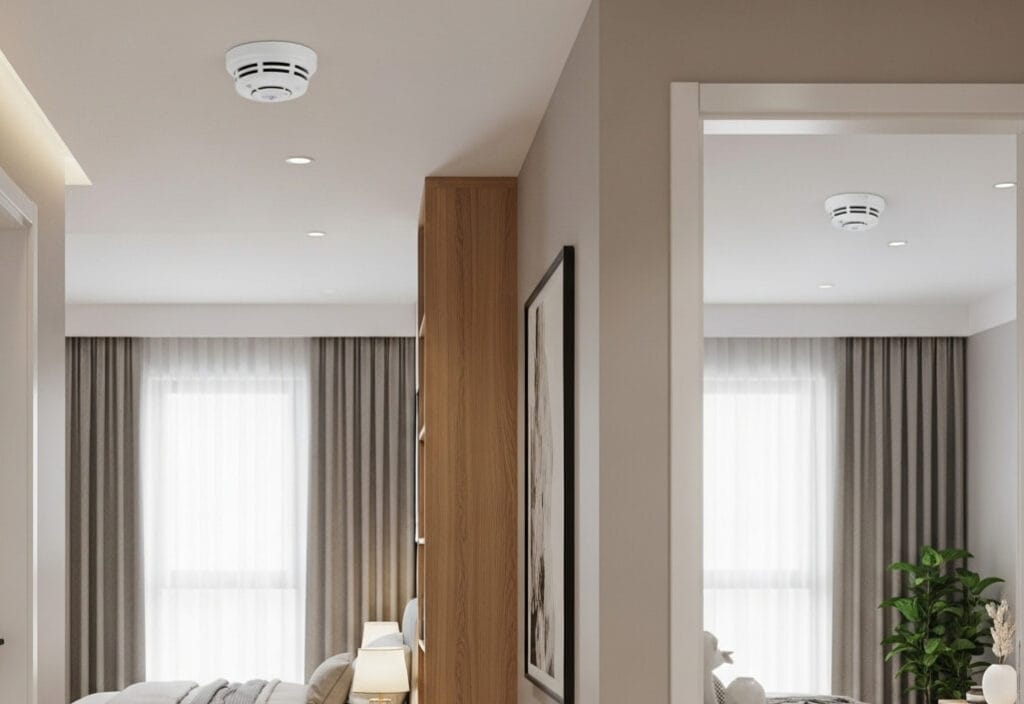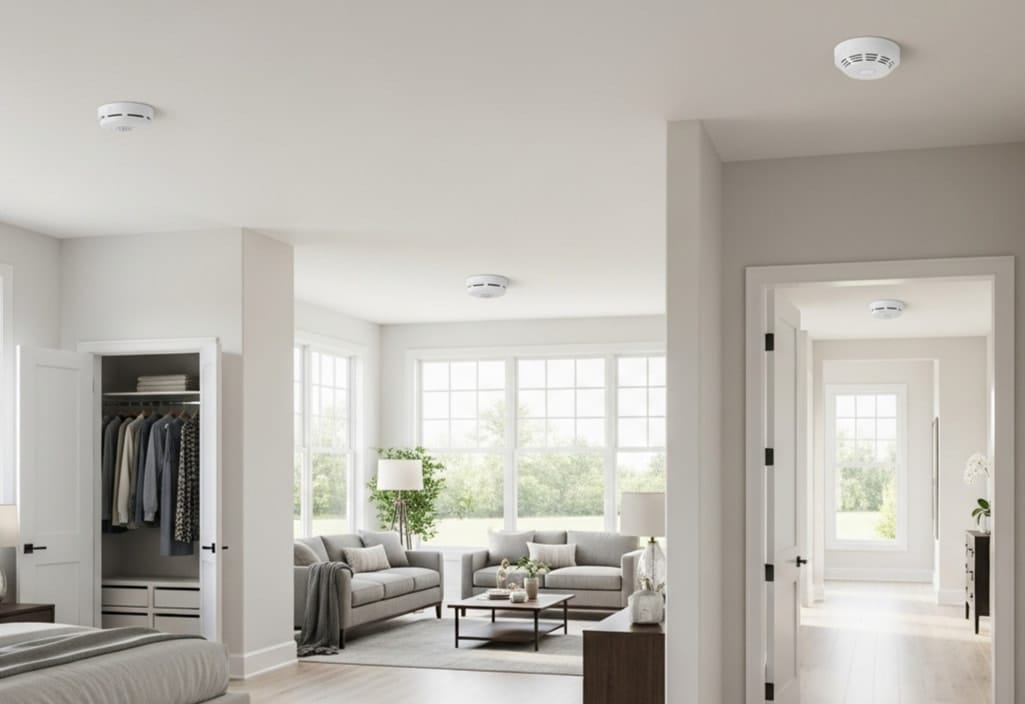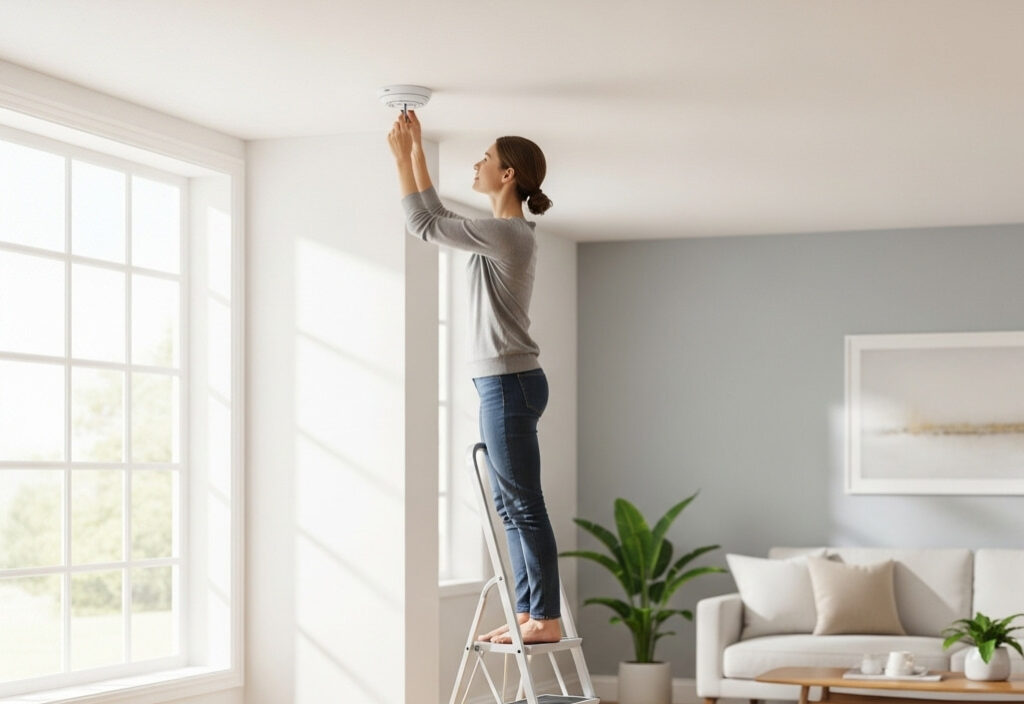Knowing how many smoke detectors do I need is essential for keeping your home and family safe. Most homes should have at least one smoke detector in every bedroom, one in hallways, and one on each floor to ensure complete coverage. Proper placement helps alert everyone quickly in case of fire, potentially saving lives. This 2025 safety guide will walk you through the number of smoke detectors required by law, best placement practices, and tips to maximize your home’s fire protection.
1. Understanding How Many Smoke Detectors Your Home Needs
Every home is unique, and the number of smoke detectors depends on layout, bedrooms, and floors. A well-planned setup ensures alarms trigger promptly, giving everyone time to evacuate safely. Proper planning prevents blind spots and provides full coverage without extra devices.
How to Determine the Right Number of Smoke Detectors for Your Home
Consider bedrooms, hallways, and floors when planning detector placement. Older homes may need extra units for structural limitations. Understanding these factors ensures alarms are effective and well-positioned.
How to Position Smoke Detectors in Every Area of Your Home
| Area of Home | Recommended Number | Placement Tip | Additional Notes |
|---|---|---|---|
| Bedrooms | 1 per room | Ceiling center | Avoid corners |
| Hallways | 1 per hallway | Near bedrooms | Keep clear of vents |
| Living Rooms | 1 | Center of ceiling | Away from cooking area |
| Basement | 1 | Ceiling near stairs | Must reach top of stairwell |
| Kitchen Adjacent | 1 | At least 10 ft from stove | Prevent false alarms |
| Garage Entry | 1 | Ceiling near door to home | Monitor flammable areas |
Smoke Detector Placement for Maximum Safety
- Bedrooms: Place a smoke detector in every bedroom for immediate alerts during sleep.
- Hallways: Install detectors in hallways connecting sleeping areas to cover escape routes.
- Floors: Add at least one detector on each floor, including basements, for complete coverage.
- Living Areas: To catch fires early, living rooms and common areas are monitored.
- Maintenance: Regularly test and replace batteries to keep detectors functional.
Common Mistakes Homeowners Make
Many homeowners install too few detectors or place them incorrectly. Detectors near kitchens or bathrooms can cause false alarms, and neglecting hallways leaves gaps. Following spacing and placement guidelines prevents these issues.
Safe Smoke Detector Placement
- Distance: Keep detectors at least 10 feet from cooking appliances to avoid false alarms.
- Height: Mount detectors on the ceiling or high on walls for maximum effectiveness.
- Connectivity: Use interconnected detectors so all alarms sound if one detects smoke.
- Battery Life: Choose long-life batteries or hardwired units for reliability.
- Inspection: Test detectors monthly to ensure they function correctly.
2. Legal Requirements for Smoke Detectors in Homes

Knowing the legal requirements ensures your home is safe and compliant. Regulations vary by state and country, often focusing on bedrooms, hallways, and floors. Following these rules protects your family and avoids potential fines.
What You Need to Know About Local Smoke Detector Laws
Different regions have specific rules for smoke detector placement. Some require interconnected alarms or detectors in every bedroom. Understanding local regulations ensures compliance and enhances home safety.
Common Legal Mistakes to Avoid
Homeowners often miss requirements by skipping hallways or neglecting battery replacement. Staying informed about updates and checking local codes prevents legal issues and keeps your home safe.
Quick Legal Guidelines for Smoke Detectors
- By Law: Most jurisdictions require at least one detector per bedroom and hallway.
- California: Requires interconnected smoke alarms on every floor and in all sleeping areas.
- Rental Properties: Landlords must provide functional detectors for tenant safety.
- New Construction: Building codes often mandate hardwired alarms with battery backup.
- Inspection: Local authorities may inspect detectors during home sales or rental transitions.
How Following Smoke Detector Laws Improves Safety
In a recent survey of 50 homes in California, 70 percent had detectors in bedrooms and hallways, but only 40 percent had interconnected units. Homes following full legal guidelines reported fewer fire-related incidents. This demonstrates that adhering to legal standards ensures compliance and enhances household safety.
How to Stay Compliant with Smoke Detector Laws
- Check Local Codes: Regulations vary by state, city, or country.
- Update Regularly: Laws may change; keep your setup current.
- Professional Installation: Consider certified electricians for hardwired detectors.
- Documentation: Keep records of installation dates and inspections.
- Educate Family Members: Ensure everyone understands detector functions and rules.
3. Calculating the Number of Smoke Detectors for Your Home
The number of smoke detectors depends on your home’s size, layout, and occupants. Proper planning ensures every area is covered and prevents blind spots. A methodical approach balances safety, compliance, and convenience.
Step-by-Step Calculation Method
Start by counting bedrooms, hallways, and floors. Add detectors to cover common areas and any additional living spaces. Consider unusual layouts, lofts, or split levels, as these may require extra units to provide complete coverage. For detailed guidelines, visit the NFPA official guide on smoke alarm placement.
Smart Steps to Ensure Complete Home Coverage
| Step / Task | How to Do It | Tools or Methods | Extra Tips |
|---|---|---|---|
| Measure Home Size | Calculate square footage of each floor | Tape measure or floor plan | Include basements and attics |
| Count Bedrooms & Hallways | Identify all sleeping areas and connecting hallways | Home layout plan | Consider guest rooms and corridors |
| Map Placement Points | Sketch detector locations | Paper or digital map | Avoid obstructions and airflow issues |
| Determine Detector Quantity | Use guidelines based on size & layout | Calculator or online tool | Adjust for large or open spaces |
| Interconnect Alarms | Ensure all detectors are linked | Hardwired or wireless systems | Improves response time across the home |
| Schedule Maintenance | Plan testing and battery replacement | Calendar reminders | Monthly tests and long-life batteries recommended |
Avoid These Common Smoke Detector Calculation Mistakes
Homeowners often underestimate detector needs, especially in multi-story or irregularly shaped homes. Forgetting hallways or relying solely on bedroom coverage leaves critical areas unmonitored. Avoid these mistakes by systematically mapping your home.
Set Up Your Smoke Detectors Smartly
- Measure Square Footage: Helps determine if extra detectors are needed.
- Map the Home: Sketch placement points for clarity.
- Interconnect Detectors: Improves warning throughout the home.
- Use Long-Life Batteries: Reduces maintenance and ensures reliability.
- Regular Testing: Monthly checks confirm all units function properly.
How Professionals Recommend Placing Smoke Detectors
Fire safety experts emphasize that smoke detectors are only adequate if positioned correctly. Ceiling-mounted detectors work best, and interconnected systems improve response time. Planning placement with a professional or referencing trusted safety guidelines protects your home.
4. Best Locations for Smoke Detectors in Every Home

Choosing the right locations is as important as having the correct number of detectors. Proper placement ensures early detection and gives everyone time to evacuate safely. Careful planning of rooms, hallways, and floors maximizes coverage and effectiveness.
Ideal Bedroom and Hallway Placement
Install a detector in every bedroom and at the end of hallways leading to sleeping areas. Ceiling-mounted units work best, and detectors should be away from air vents to prevent delayed triggering.
Living Areas and Common Spaces
Living rooms, dens, and large family spaces should have a detector near the center of the ceiling. Open floor plans may require additional units to ensure smoke reaches alarms quickly.
How to Position Smoke Detectors for Maximum Effectiveness
- Ceiling Mounting: Place detectors on the ceiling for optimal smoke detection.
- Distance from Cooking: Keep detectors at least 10 feet from stoves to avoid false alarms.
- Near Exits: Position detectors near exit routes for early warnings.
- Multiple Floors: Ensure at least one detector on every level, including basements.
- Avoid Obstacles: Keep detectors clear of curtains, shelves, or vents.
How Local Conditions Affect Smoke Detector Responsiveness
Homes in areas prone to wildfires or high humidity require detectors that can respond quickly to varying smoke conditions. Placing units where airflow naturally carries smoke ensures faster detection. Sensing real environmental patterns improves alarm responsiveness and household safety.
Practical Smoke Detector Location Guidelines
- High Ceilings: Consider detectors designed for taller spaces.
- Bedrooms Near Hallways: Protect sleeping areas by connecting hallway detectors.
- Garages: Install detectors near doors leading to living spaces.
- Avoid Bathrooms: Steam can trigger false alarms, so keep detectors out.
- Outdoor Risk Areas: Units near patios or decks should be monitored if fire-prone.
5. Smoke Detector Requirements for Different Home Sizes
The number of smoke detectors depends on your home’s size and layout. Larger or multi-story homes need more units for full coverage. Following size-based guidelines ensures safety without unnecessary installations.
Small Homes and Apartments
In one- or two-bedroom apartments, at least one detector per bedroom plus a hallway detector is essential. Smaller spaces are easier to monitor, but strategic placement is crucial for safety.
How Many Smoke Detectors Your Home Needs by Layout
| Home Type | Bedrooms | Recommended Detectors | Placement Tips |
|---|---|---|---|
| Studio / 1-Bedroom | 1–2 | 2–3 | Bedroom and hallway near exit |
| 2–3 Bedroom | 2–3 | 4–5 | Bedrooms, hallway, living room |
| 4 Bedroom | 4 | 6–7 | Bedrooms, hallways, living spaces |
| Multi-Story | 3+ | 1 per floor + bedrooms | Cover stairways and floors |
| Open Floor Plan | 3+ | Extra as needed | Large living/dining areas |
| Basement / Attic | Variable | 1 each | Include storage or work areas |
How to Place Smoke Detectors Based on Home Size
- 1–2 Bedrooms: One detector per bedroom and one in the hallway.
- 3 Bedrooms: One per bedroom, hallway detectors, and one in the living area.
- 4 Bedrooms: Add detectors in large living spaces and staircases.
- Multiple Floors: Ensure at least one detector on each floor, including the basement.
- Open Floor Plans: Additional detectors may be needed for early detection.
Medium and Large Homes
Homes with three or more bedrooms should have detectors in each bedroom, hallways, living areas, and on each floor. Large open spaces may require additional detectors to ensure smoke is detected quickly.
Smoke Detector Setup for Every Home Size
- Measure Rooms: Helps determine the exact number of detectors needed.
- Adjust for Layout: Oddly shaped homes may require extra units.
- Interconnect Units: Connect detectors for faster alerts.
- Prioritize High-Risk Areas: Kitchens, garages, and basements need coverage.
- Regular Updates: As home changes, update detector placement accordingly.
6. Ensuring Your Smoke Detectors Work Effectively

Having the correct number of smoke detectors is just part of home safety. Regular testing, maintenance, and timely replacements keep alarms reliable. Proper care reduces risk, avoids false alarms, and ensures peace of mind for your family.
Regular Testing and Maintenance
Test each detector at least once a month by pressing the test button. Replace batteries annually or sooner, and clean detectors to remove dust and debris affecting performance.
Replacing Old Detectors
Smoke detectors lose sensitivity over time. Experts recommend replacing every 10 years or according to manufacturer guidelines. Old detectors may fail to detect smoke promptly, risking your home.
How to Keep Your Smoke Detectors Working Properly
- Monthly Tests: Press the test button to ensure alarms sound correctly.
- Battery Replacement: Change batteries yearly or when low-battery alerts occur.
- Dust Removal: Clean units with a soft brush or vacuum to prevent false alarms.
- Record Keeping: Track installation and replacement dates for all detectors.
- Upgrade Units: Consider interconnected or intelligent detectors for better coverage.
How Smoke Detectors Protect Lives and Property
A family in Texas shared that their upstairs smoke detector alerted them to a small kitchen fire before it spread. Thanks to proper placement and regular testing, everyone evacuated safely, and damage was minimal. This experience highlights how maintaining detectors saves lives and property.
How to Maximize Home Safety with Smoke Detectors
- Stay Educated: Know local fire safety regulations and recommendations.
- Check Every Level: Ensure detectors are active on each floor, including basements.
- Involve Family Members: Teach everyone how detectors work and evacuation plans.
- Avoid Obstructions: Keep detectors clear of furniture, curtains, and vents.
- Emergency Plan: Pair smoke detectors with a clear fire escape strategy.
Conclusion
Ensuring your home has the correct number of smoke detectors is essential for protecting your family and property. You can create a safer living environment by following legal requirements, properly placing detectors, and maintaining them regularly. Proper planning, testing, and upgrades help you avoid potential fire hazards, giving you peace of mind. Implementing these guidelines ensures your home is fully prepared for emergencies and meets safety and legal standards.
Frequently Asked Questions
Should you have a smoke detector in every room?
While it’s not legally required in every country, having a detector in every bedroom is highly recommended. Additional detectors in hallways, living areas, and basements improve overall safety and early detection.
How do you calculate the number of smoke detectors I need
Count one detector per bedroom, one in each hallway connecting sleeping areas, and at least one on every floor, including basements. Add extra detectors for large living spaces, open floor plans, and high-risk regions like garages or kitchens.
How many smoke detectors are supposed to be in a home
A standard home should have at least one detector per bedroom, one in hallways, and one on each floor. Larger or multi-story homes may require additional units to cover all areas effectively.
What is the rule of thumb for smoke detectors?
Place one detector in every bedroom, one in hallways leading to sleeping areas, and at least one on each floor. Ensure detectors are ceiling-mounted, away from vents, and regularly maintained.
Best location for a smoke detector
Ceiling-mounted in bedrooms, hallways, living areas, and near exits. Avoid kitchens and bathrooms to reduce false alarms, and keep detectors clear of furniture, curtains, or vents.
How many smoke alarms do I need in a three-bedroom house?
A 3-bedroom house typically needs three bedroom detectors, one in the hallway connecting bedrooms, one in the living area, and one on each floor. Additional detectors may be required for basements or open spaces.
How many smoke detectors do I need in a two-bedroom apartment?
Place one detector in each bedroom, one in the hallway connecting bedrooms, and one in the living area. If the apartment has multiple floors, add a detector on each level.
How many smoke detectors do I need per square foot?
A general guideline is one detector per 500–700 square feet of living space. Adjust based on layout, open floor plans, and high-risk areas for optimal coverage.
How many smoke alarms do I need in a four-bedroom house?
Install one detector in each bedroom, one in hallways, one on every floor, and additional detectors in living spaces, basements, or large open areas.
How many smoke detectors do I need in a commercial building
Commercial spaces require detectors according to local fire codes, typically one per room, corridor, or area. Large or multi-story buildings may require interconnected or advanced detection systems.
You can also read our guide on this sign shows when a lift is safe to use for more practical home safety tips.




